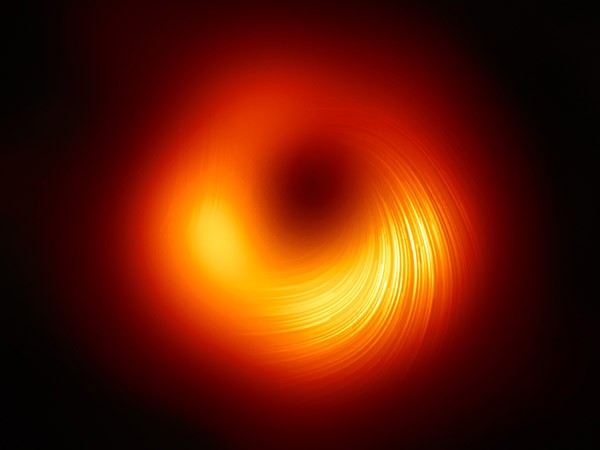Hello Nature readers, would you like to get this Briefing in your inbox free every day? Sign up here
This swirling version of the now-iconic black hole at the centre of the M87 galaxy reveals the nature of the region’s magnetic field. The image was produced by the Event Horizon Telescope (EHT) — which in 2019 produced the first-ever image of a black hole. It shows polarized light emitted by jets hurled by the black hole, accelerating along magnetic fields as they go. “The polarised light has these curved swoops like a spiral,” says astrophysicist Sara Issaoun. “This tells us that the magnetic field around the black hole is ordered, and this is really important because only an ordered magnetic field can launch jets — a scrambled magnetic field cannot do that.”
New Scientist | 3 min read
Read more: Black hole pictured for first time — in spectacular detail (Nature | 7 min read, from 2019)
Reference:The Astrophysical Journal Letters paper 1 & paper 2
Archaeologists in China have unveiled more than 500 artefacts from six ‘sacrificial pits’ in Sanxingdui dating back more than 3,000 years. The site in southwestern Sichuan province provides a glimpse into an ancient civilization at the heart of what is thought to be the Shu kingdom. The findings include artistic carvings on a bean-sized piece of ivory, and fragments of a golden mask described as a “rare, dazzling treasure” by archaeologist Zhao Congcang.
Sixth Tone | 5 min read
Scientists have identified a molecular switch that controls brain growth, making human brains three times larger than those of great apes. In studies on mini-brains grown in a dish, they were able to tinker with the mechanism to make gorilla brain tissue larger and human brain tissue smaller.
The Guardian | 4 min read
Reference: Cell paper
Features & opinion
Table of Contents
Evidence is growing that the SARS-CoV-2 variants that are evolving around the world share similar combinations of mutations, writes evolutionary microbiologist Vaughn Cooper. In the United States, Cooper’s laboratory has found at least seven genetically independent lineages that acquired a mutation at one particular spot on the virus’s infamous spike protein. Limiting infections will be key to reducing the virus’s opportunity to mutate in ways that make it even more dangerous. “These viral adaptations are already rewriting our biology textbooks on convergent evolution,” writes Cooper. “Let’s strive to limit new material.”
Scientific American | 6 min read
Hundreds of workers have been exposed to extreme amounts of lead at Florida’s lone lead smelter, which recycles car batteries. A Tampa Bay Times investigation, which is being revealed in a series of stories starting today, reveals dangerous levels of the neurotoxin and the profound consequences for workers and their families.
Tampa Bay Times | 24 min read
If you’ve got a €5,000 bottle of Château Pétrus languishing in your wine cellar, it can get a boost merely by spending a year on the International Space Station. The same vintage left behind on Earth tastes “a bit younger” than the astro-plonk, says wine expert Jane Anson. But if you don’t have a spare spaceship seat reserved for your favourite tipple, fret not. They were both still “absolutely gorgeous”, says Anson.
I’ll be raising a toast (sadly not of Château Pétrus) to you if you send me your comments on this newsletter. Please e-mail your feedback to briefing@nature.com.
Flora Graham, senior editor, Nature Briefing
With contributions by Smriti Mallapaty

